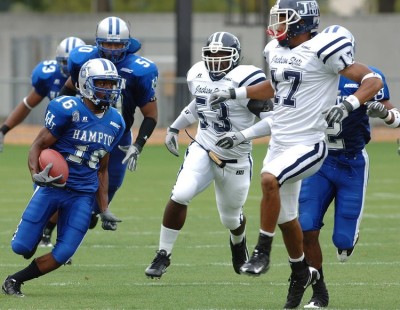Two years later, students continue to bear a heavy burden for the pursuit of athletics. Our report is a follow up to the 2014 article where the SWAC and MEAC, without student subsidies were losing $130 million annually in athletics in 2013. It is unfortunate to report that the situation has not improved and has in fact gotten worse. HBCUs, especially the SWAC and MEAC, do not have the luxury of boosters like oil tycoon T. Boone Pickens, Nike’s owner Phil Knight, or even Under Armour’s owner Kevin Plank who give millions annually. In the case of Phil Knight, he and his wife have plowed over $300 million into the University of Oregon’s athletic program to bring it to national prominence. An amount that would cover the student fee contributions by SWAC and MEAC students – twice.
Each year the SWAC and MEAC meet for the SWAC/MEAC Challenge sponsored by Disney and this year will meet in the second annual Celebration Bowl, a post-season game to determine the HBCU “national” champion. Sports are an integral part of the college experience this can not be argued, but at what cost? HBCU students, despite HBCUs in general being cheaper than their PWI counterparts, graduate with higher student debt loads. This often delays and/or prevents all together them from becoming future donors back to their schools or boosters to athletics. The lack of African American wealth, both in households and institutions, no doubt plays a huge role. However, the question remains are we sacrificing too much today and forever burdening ourselves tomorrow?
REVENUES (in millions)
Total: $189.5 (up 7.1% from 2013)
Median: $10.2 (up 29.1% from 2013)
Average: $9.5 (up 18.8% from 2013)
Highest revenue: Norfolk State University $16.1 million
Lowest revenue: Coppin State University $3.4 million
EXPENSES (in millions)
Total: $194.1 (up 8.6% from 2013)
Median: $10.1 (up 27.8% from 2013)
Average: $9.7 (up 19.8% from 2013)
Highest expenses: Norfolk State University $16.1 million
Lowest expenses: Coppin State University $3.9 million
SUBSIDY
Total: $142.5 (up 12.3% from 2013)
Median: $7.9 (up 43.6% from 2013)
Average: $7.1 (up 22.4% from 2013)
Highest subsidy: Norfolk State University $13.5 million
Lowest subsidy: Mississippi Valley State University $2.3 million
PROFIT/LOSS (W/ SUBSIDY)
Total: $-4.6 million (down 142% from 2013)
Median: $-2 000 (in 2013 median was zero)
Average: $-230 071 (down 188% from 2013)
Highest profit/loss: Alabama A&M University $215 207
Lowest profit/loss: Grambling State University $-2 044 323
PROFIT/LOSS (W/O SUBSIDY)
Total: $-147.1 million (down 14.4% from 2013)
Median: $-7.8 million (down 34.5% from 2013)
Average: $-7.4 million (down 27.6% from 2013)
CONCLUSION: The SWAC and MEAC have a challenge, but its not on the fields or hardwoods. It is, however, on the income statements and balance sheets of their athletic departments. HBCU b-schools need to be desperately tasked with the assignment of scribing a new business model for HBCU athletics that takes into account alumni wealth (or lack thereof), minuscule payouts by corporations (Celebration Bowl provides roughly $87 000 to each school), and other factors unique to HBCU sports if they are going to lessen the burden on their students who are currently providing 75 percent of the revenues. At current student loan interest rates and traditional investment return rates, the debt burden for just these athletic fees is $1.1 billion over the next 30 years and an investment loss of $4.5 billion over the same period, respectively. These have long-term consequences to families, HBCU endowments, HBCU athletics, ultimately could become cancerous to the very survival of the institutions themselves.
Editor’s Note: Howard and Hampton are excluded in this report because they are private institutions and their athletic finances were not included in this report or the 2013 report. Chicago State, which was included in the 2013 report was excluded in this report.


Pingback: The $6 Billion Delusion Of Grandeur: HBCU Alumni Refuse To Accept The Harsh Financial Reality Of HBCU Athletics | HBCU Money
Pingback: Howard v. Harvard: Financial Takeaways From The HBCU-Ivy League Game Of The Century (Or So We Hoped) | HBCU Money
Pingback: The future of HBCU football – Nogagames
Pingback: The future of HBCU football - IPLScore.live
Pingback: The 2019-2020 SWAC/MEAC Athletic Financial Review | HBCU Money